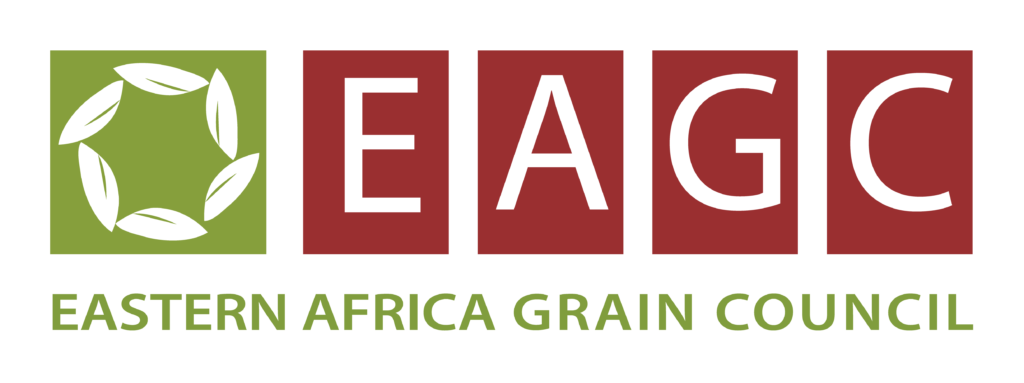
Related sites
G-SOKO
Grain Business Institute
African Grain Trade Summit
Climate Information for Grains
Address
Mbaazi Avenue, Off King’ara Road
P.O Box 218-00606, NAIROBI
Tel:+254(0)20-3745840
Cell: +254733444035 /710607313
E-mail: grains@eagc.org
Boasting of a 16-year history as the premier membership-driven grain trade support organization in Eastern Africa, EAGC has developed the requisite reputation and partnerships that uniquely positions it to ably serve market actors across the various grain value chains.
In her quest to achieve the objective of facilitating efficient, structured, inclusive, and profitable grain trade in Eastern Africa, EAGC has since its inception developed and has been implementing various programs with the support of various partners, both from the public and the private sector at national, regional and international levels…
Structuring grain markets for More Trade and Better Trade
Grain Aggregation Systems: EAGC has a network of over 500 VACs spread across the region. The VACs form the fundamental basis of structured grain trading system that EAGC has been developing. Through VACs, farmers have benefitted from the post-harvest technologies introduced to them, trained on structured trading and linked to formal markets.
Grain Trade Business Hubs (G-Hubs): The idea behind the establishment of the G-Hubs was to transform the aggregation centers into trade units that would provide the grain trade-related services in a commercial and sustainable manner. The EAGC G-Hub Model enhances smallholder farmer’s access to inputs such as seeds and fertilizer, get market information and learn about grades and standards. In addition, smallholder farmers would aggregate their produce in their own store as a farmer group and sell collectively.EAGC has developed a GHUB system for registration and profiling of small holder farmers based on their needs majorly focusing demand for agricultural inputs, Post Harvest Handling equipment, machinery and services,grain storage and warehousing , capacity building and training, market information and policy advocacy as well as market linkages and market access.
Warehouse Inspection & Certification: This is a service for EAGC Members to have their warehouses certified for effective trade and better quality of their produce. The certified warehouses are linked to the trade platform for support in guarantee of quality to the buyers and benefit from Structured trade.EAGC has automated the warehouse receipting processes and has an electronic warehouse receipting system (eWRS)which has also been leased to the Warehouse Receipt Systems Council for the management of warehouse receipts since 2021 January.
The G-Soko system: The software system was successfully migrated from Virtual City to EAGC server system and shared services delinked. The migration was triggered by the cost of hosting and maintenance, the security data transmission and security system. EAGC has independently run the system since migration and learned that the members still require a user-friendly system, and this occasioned the upgrade of the system to provide an android version which is easier to install and use. EAGC in 2022 will start leasing the GSOKO online trading platform to the Warehouse Receipt Systems for the trade of the warehouse receipts nominated for trade from the eWRS.
EAGC Trade Finance Solutions: This tool was developed to support the financial institutions make decisions on trade finance. The tool helps to mitigate the risk of reduced value of the collateral (grain) in the warehouse. It monitors the commodity market value/ market prices and if the prices depreciate, a trigger is generated to force the sale of the commodity at a price that’s suitable to the bank and borrower.
GSOKO Collateral Management Service (CMS): The GSOKO CMS is a form of Inventory Financing Solution that is designed to address the prevailing liquidity constraints affecting the grain suppliers and millers. The Solution is aimed at unlocking the lack of trade finance by grain buyers who are required to buy large volume of grain for their buyers or for their milling operations, but they do not have security for borrowing. The GSOKO CMS solution comprises of the following:
The EAGC CMS has the following features:
The CMS is integrated with two (2) financing models depending on the type of the borrower:
Trade facilitation realized from EAGC STS interventions
Business to Business (B2B) Forums
Three Business to Business meetings were hosted in 2021 which resulted in 26 trade contracts of various grains amounting to 128,562 MT signed. Actualization of the trade is key to EAGC and as such EAGC Secretariat supported contracting parties to actualize trade including support to access finance.
One on one Cross Border Trade Linkages
One on One local trade linkages in Kenya under the Kenya Cereal Enhancement Program (KCEP)
Trade through the EAGC GSOKO trading platform
Facilitating trade through Grain Trade Business Hubs (GHUBs)
Warehouse inspection, reinspection and digitization of GHUB warehouses
In Kenya:

Mbaazi Avenue, Off King’ara Road
P.O Box 218-00606, NAIROBI
Tel:+254(0)20-3745840
Cell: +254733444035 /710607313
E-mail: grains@eagc.org
Copyright © 2024 Eastern Africa Grain Council